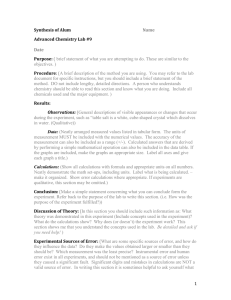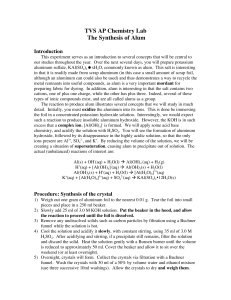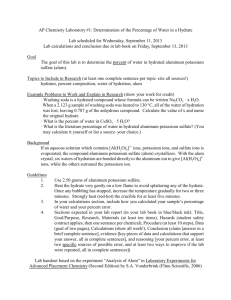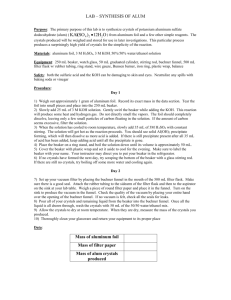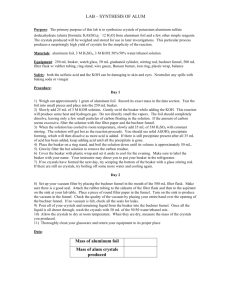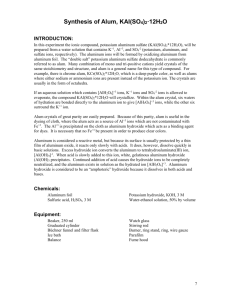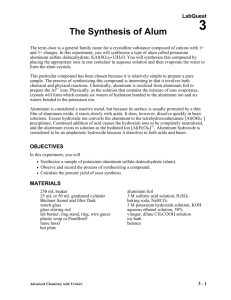Synthesis of Alum Lab
advertisement
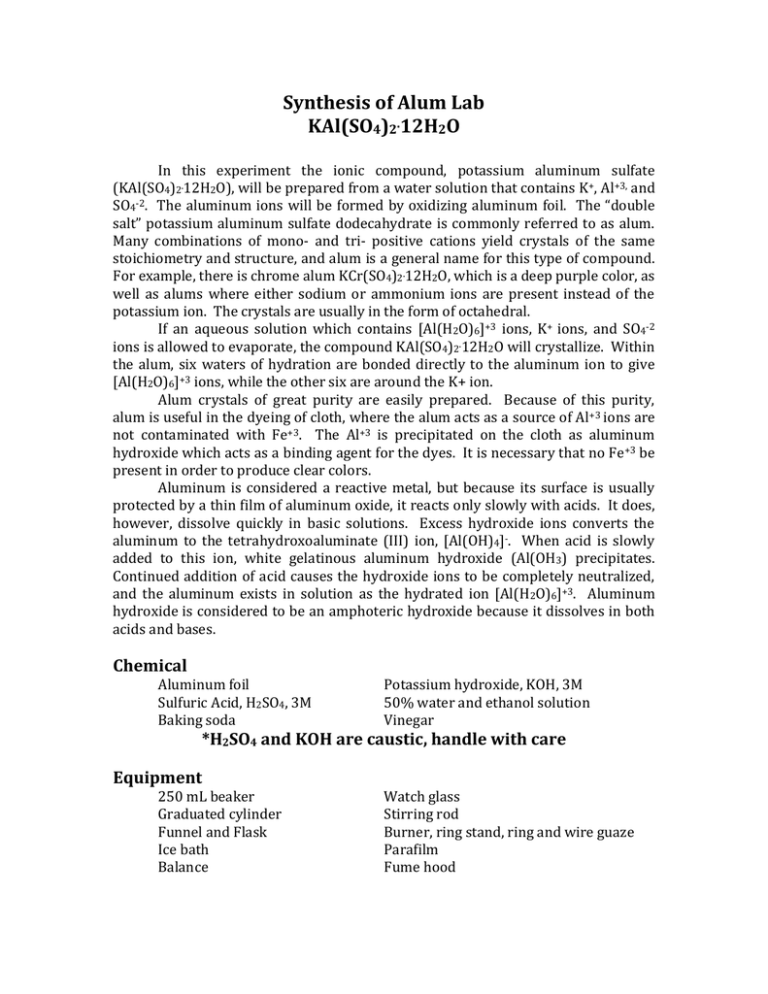
Synthesis of Alum Lab KAl(SO4)2.12H2O In this experiment the ionic compound, potassium aluminum sulfate (KAl(SO4)2.12H2O), will be prepared from a water solution that contains K+, Al+3, and SO4-2. The aluminum ions will be formed by oxidizing aluminum foil. The “double salt” potassium aluminum sulfate dodecahydrate is commonly referred to as alum. Many combinations of mono- and tri- positive cations yield crystals of the same stoichiometry and structure, and alum is a general name for this type of compound. For example, there is chrome alum KCr(SO4)2.12H2O, which is a deep purple color, as well as alums where either sodium or ammonium ions are present instead of the potassium ion. The crystals are usually in the form of octahedral. If an aqueous solution which contains [Al(H2O)6]+3 ions, K+ ions, and SO4-2 ions is allowed to evaporate, the compound KAl(SO4)2.12H2O will crystallize. Within the alum, six waters of hydration are bonded directly to the aluminum ion to give [Al(H2O)6]+3 ions, while the other six are around the K+ ion. Alum crystals of great purity are easily prepared. Because of this purity, alum is useful in the dyeing of cloth, where the alum acts as a source of Al+3 ions are not contaminated with Fe+3. The Al+3 is precipitated on the cloth as aluminum hydroxide which acts as a binding agent for the dyes. It is necessary that no Fe +3 be present in order to produce clear colors. Aluminum is considered a reactive metal, but because its surface is usually protected by a thin film of aluminum oxide, it reacts only slowly with acids. It does, however, dissolve quickly in basic solutions. Excess hydroxide ions converts the aluminum to the tetrahydroxoaluminate (III) ion, [Al(OH)4]-. When acid is slowly added to this ion, white gelatinous aluminum hydroxide (Al(OH3) precipitates. Continued addition of acid causes the hydroxide ions to be completely neutralized, and the aluminum exists in solution as the hydrated ion [Al(H2O)6]+3. Aluminum hydroxide is considered to be an amphoteric hydroxide because it dissolves in both acids and bases. Chemical Aluminum foil Sulfuric Acid, H2SO4, 3M Baking soda Potassium hydroxide, KOH, 3M 50% water and ethanol solution Vinegar *H2SO4 and KOH are caustic, handle with care Equipment 250 mL beaker Graduated cylinder Funnel and Flask Ice bath Balance Watch glass Stirring rod Burner, ring stand, ring and wire guaze Parafilm Fume hood Procedure 1. Weigh Out and Dissolve the Aluminum Weigh out about 1 gram of aluminum foil. Tear the foil into small pieces and place into a 250 mL beaker. Slowly add 25 mL of 3M KOH solution. Allow the reaction to proceed until all of the foil is dissolved. Remove any undissolved solids such as carbon particles by filtering the solution. Rinse the filter paper with a small amount of distilled water. 2. Acidify with Sulfuric Acid At this point the solution contains [Al(OH)4]- and K+ ions, along with excess OH- ions. Cool the solution and then acidify SLOWLY, with constant stirring, using 35 mL of 3M H2SO4. The solution will get very hot because you are adding strong acid to the strongly basic solution. Solid Al(OH)3 will first precipitate and then dissolve as more H2SO4 is added. If a precipitate still remains, filter the solution and discard the solids. Then boil the solution until water evaporates to give a volume of about 50 mL of solution. This is a good place to stop if the end of the lab period is near. Cool the solution and cover the beaker with Parafilm. Allow it to rest undisturbed until the next period. 3. Crystallize the Alum If time permits, cool the solution in an ice bath for 15 minutes, keeping it as motionless as possible. Crystals should grow in the beaker. If no crystals form, scrape the bottom of the beaker with a stirring rod to create a rough place where crystals might begin to grow, or add a seed crystal. If there are still no crystals, reheat the solution until more water has evaporated and then cool again. Rapid cooling in an ice bath causes very small crystals to grow; slow overnight cooling allows the formation of larger crystals. Collect the alum crystals through filtration. Wash the crystals with 50 mL of a 50% by volume water and ethanol mixture, in which alum crystals are not very soluble. Allow the crystals to dry at room temperature. Determine the mass of the alum. Calculate the theoretical yield of alum assuming that aluminum was the limiting reactant and that the foil was 100% aluminum, and calculate your percent yield. Questions: Answer the following in your lab report 1. Write balanced net ionic equations for the following reactions that occur in this synthesis: a. Aluminum reacts with potassium hydroxide and water forming potassium ions, [Al(OH)4]-, and hydrogen gas. b. Hydrogen ions from the acid react with the [Al(OH)4]- ions to precipitate aluminum hydroxide. c. Aluminum hydroxide reacts with additional hydrogen ions and water to form [Al(H2O)6]+3. d. Alum forms from the potassium ions, hydrated aluminum ions, sulfate ions and water. 2. What is a synthesis reaction? 3. Why should you not expect a 100% yield of crystals? 4. How does the solubility of alum in water change with teperature? 5. Why should you not wash the crystals with water? 6. What do your crystals look like? 7. What is the shape of an octahedron?
